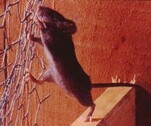Pest Information » Mice
Mice

HOUSE MOUSE (Mus musculus)
INTRODUCTION:
The house mouse is the most commonly encountered and economically important of the commensal rodents, the Norway and roof/black rats being the other two. House mice are not only a nuisance, they damage/destroy materials by gnawing, and eat and contaminate stored food, they are also of human health importance as disease carriers or vectors. It is thought to be of Central Asian origin, but is now of world-wide distribution and found throughout New Zealand.
RECOGNITION:
Adult with head and body length 2.5-3.5" (6.5-9 cm), tail length 2 3/4-4" (7-10.2 cm), weight about 1/2-1 oz (12-30 g). Fur smooth, colour usually dusty grey above and light grey or cream on belly (some mice light brown to dark grey above), but fur colour varies considerably from area to area or location to location regardless of living habits.
SIGNS OF INFESTATION:
1. Gnaw marks. New gnawings or holes tend to be rough whereas, old gnawings are smooth from wear.
2. Droppings. Fresh droppings are soft and moist whereas, old droppings are dried and hard; house mouse's about '1/8-1/4" (3-6 mm) long, rod shaped, and with
pointed ends vs American cockroach about 1/8" (3 mm) long and with ridges.
3. Tracks/footprints. Front foot 4-toed and print is in front of hind print with 5-toes. Fresh tracks are clear and sharp whereas, old tracks are at least partially
obscured by dust.
4. Rub marks are usually less noticeable and smaller in size than those of rats.
5. Burrows. Indoors they often nest in various materials such as insulation. If active, free of dust and cobwebs. Entrance usually with material packed/compressed, rub marks sometimes visible.
6. Runways. Frequently use the same paths, usually along walls, stacked merchandise, etc., and to interior objects. Active runways free of dust and cobwebs, with fresh droppings. Tracks may or may not be visible.
7. Damaged goods. Mice prefer seeds or cereals.
BIOLOGY:
The house mouse is a prolific breeder. They reach sexual maturity in 35 days. Pregnancy lasts an average of 19 days (range 18-21). The average litter size is 6 (range 5-8), with about 8 litters per year, but averaging 30-35 weaned/female/year. Therefore, a female can have a new litter about once every 40-50 days. More than 1 litter may be present in the nest at one time. Life expectancy is normally less than 1 year, but mice have been known to live as long as 6 years.
Over a 6-month period, a pair of mice will eat about 4 pounds (1.8 kg) of food, produce about 18,000 droppings, and void about 3/4 pint/12 oz. (355 ml) of urine.
The most common way mice transmit disease organisms is by contaminating food with their droppings and/or urine.
The most threatening organism spread by mice is Salmonella, a cause of food poisoning, spread via droppings. Other transmittable organisms include tapeworms via droppings, rat-bite fever via bites, infectious jaundice/leptospirosis/Weil's Disease via urine in food or water, a fungus disease (Favus) of the scalp either by direct contact or indirectly via cats, plague and murine typhus via fleas, Rickettsial pox via the mite Liponyssoides sanguineus (Hirst), lymphocytic choriomeningitis via droppings, and possibly poliomyelitis (polio). Another problem is house mouse mite dermatitis which is caused by these mites when they feed on humans.
HABITS:
Mice are very social. Related males and females are compatible, but unrelated male mice are typically very aggressive toward one another. Social hierarchies with one male dominating lower-ranking males result in the maintenance of territories, which may
include a large number of females as well as lower-ranking males, most of which will be related. All mature mice tend to show aggression towards strangers of either sex that enter their territory, which is marked with urine.
Territory size varies but it is usually relatively small. If food and shelter are plentiful, they may not travel more than 4-5 feet (1.2-1.5 m) from their nests.
Mice are inquisitive. During the daily territorial patrol, they will explore anything new or changed, and establish new travel routes if needed. Mice are nibblers and eat only small amounts of food at any one time or place. Although mice will eat many kinds of food, seeds are usually preferred. There are 2 main feeding periods, at dusk and just before dawn, with many other "mini" feeding times in between. They will sample new foods but return to the old food unless the new food is preferred. Required moisture is normally obtained from their food but they will take free water when available, especially when feeding on high-protein food. When given a choice, they prefer sweetened liquids over plain water.
Their preferred nesting sites are dark, secluded places where there is abundant nesting material nearby and little chance of disturbance. Nesting materials include paper products, cotton, packing materials, wall/attic insulation, fabrics, etc. Mice are nocturnal in habit. They require an opening of greater than 1/4" (6 mm) to gain entry.
INTRODUCTION:
The house mouse is the most commonly encountered and economically important of the commensal rodents, the Norway and roof/black rats being the other two. House mice are not only a nuisance, they damage/destroy materials by gnawing, and eat and contaminate stored food, they are also of human health importance as disease carriers or vectors. It is thought to be of Central Asian origin, but is now of world-wide distribution and found throughout New Zealand.
RECOGNITION:
Adult with head and body length 2.5-3.5" (6.5-9 cm), tail length 2 3/4-4" (7-10.2 cm), weight about 1/2-1 oz (12-30 g). Fur smooth, colour usually dusty grey above and light grey or cream on belly (some mice light brown to dark grey above), but fur colour varies considerably from area to area or location to location regardless of living habits.
SIGNS OF INFESTATION:
1. Gnaw marks. New gnawings or holes tend to be rough whereas, old gnawings are smooth from wear.
2. Droppings. Fresh droppings are soft and moist whereas, old droppings are dried and hard; house mouse's about '1/8-1/4" (3-6 mm) long, rod shaped, and with
pointed ends vs American cockroach about 1/8" (3 mm) long and with ridges.
3. Tracks/footprints. Front foot 4-toed and print is in front of hind print with 5-toes. Fresh tracks are clear and sharp whereas, old tracks are at least partially
obscured by dust.
4. Rub marks are usually less noticeable and smaller in size than those of rats.
5. Burrows. Indoors they often nest in various materials such as insulation. If active, free of dust and cobwebs. Entrance usually with material packed/compressed, rub marks sometimes visible.
6. Runways. Frequently use the same paths, usually along walls, stacked merchandise, etc., and to interior objects. Active runways free of dust and cobwebs, with fresh droppings. Tracks may or may not be visible.
7. Damaged goods. Mice prefer seeds or cereals.
BIOLOGY:
The house mouse is a prolific breeder. They reach sexual maturity in 35 days. Pregnancy lasts an average of 19 days (range 18-21). The average litter size is 6 (range 5-8), with about 8 litters per year, but averaging 30-35 weaned/female/year. Therefore, a female can have a new litter about once every 40-50 days. More than 1 litter may be present in the nest at one time. Life expectancy is normally less than 1 year, but mice have been known to live as long as 6 years.
Over a 6-month period, a pair of mice will eat about 4 pounds (1.8 kg) of food, produce about 18,000 droppings, and void about 3/4 pint/12 oz. (355 ml) of urine.
The most common way mice transmit disease organisms is by contaminating food with their droppings and/or urine.
The most threatening organism spread by mice is Salmonella, a cause of food poisoning, spread via droppings. Other transmittable organisms include tapeworms via droppings, rat-bite fever via bites, infectious jaundice/leptospirosis/Weil's Disease via urine in food or water, a fungus disease (Favus) of the scalp either by direct contact or indirectly via cats, plague and murine typhus via fleas, Rickettsial pox via the mite Liponyssoides sanguineus (Hirst), lymphocytic choriomeningitis via droppings, and possibly poliomyelitis (polio). Another problem is house mouse mite dermatitis which is caused by these mites when they feed on humans.
HABITS:
Mice are very social. Related males and females are compatible, but unrelated male mice are typically very aggressive toward one another. Social hierarchies with one male dominating lower-ranking males result in the maintenance of territories, which may
include a large number of females as well as lower-ranking males, most of which will be related. All mature mice tend to show aggression towards strangers of either sex that enter their territory, which is marked with urine.
Territory size varies but it is usually relatively small. If food and shelter are plentiful, they may not travel more than 4-5 feet (1.2-1.5 m) from their nests.
Mice are inquisitive. During the daily territorial patrol, they will explore anything new or changed, and establish new travel routes if needed. Mice are nibblers and eat only small amounts of food at any one time or place. Although mice will eat many kinds of food, seeds are usually preferred. There are 2 main feeding periods, at dusk and just before dawn, with many other "mini" feeding times in between. They will sample new foods but return to the old food unless the new food is preferred. Required moisture is normally obtained from their food but they will take free water when available, especially when feeding on high-protein food. When given a choice, they prefer sweetened liquids over plain water.
Their preferred nesting sites are dark, secluded places where there is abundant nesting material nearby and little chance of disturbance. Nesting materials include paper products, cotton, packing materials, wall/attic insulation, fabrics, etc. Mice are nocturnal in habit. They require an opening of greater than 1/4" (6 mm) to gain entry.
How to Protect Your House Against the Hidden Rodents that Want to Come Inside
Related Content
- Code of Practice for the Food Industry
- Using Pesticides Around the Home
- Stay safe when using Poisons around the home
- Advice for Vets about rodenticide poisoning
- Ants
- Bed Bugs
- Bees
- Black Beetle
- Black Field Cricket
- Brown Marmorated Stink Bug
- Click Beetle
- Cluster Flies
- Cockroaches
- Flies
- Mice
- Mosquitoes
- Rats
- Spiders
- Tropical House Cricket
- Wasps
